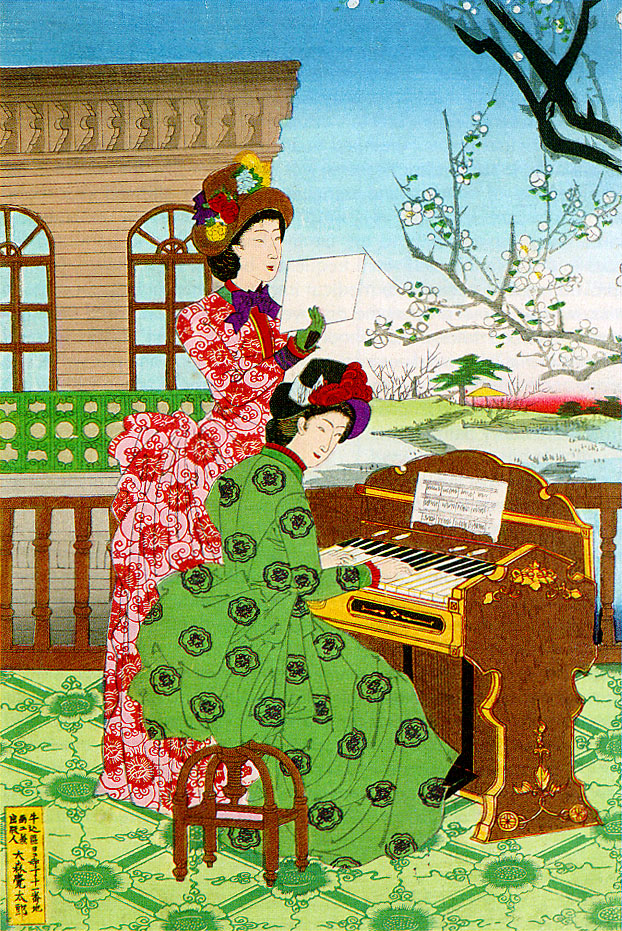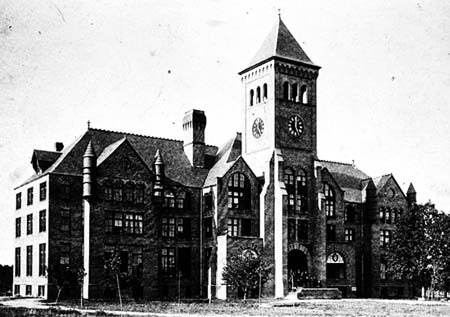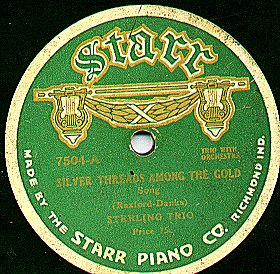|
Aeolian Company
The Aeolian Company was a musical-instrument making firm whose products included player organs, pianos, sheet music, records and phonographs. Founded in 1887, it was at one point the world's largest such firm. During the mid 20th century, it surpassed Kimball to become the largest supplier of pianos in the United States, having contracts with Steinway & Sons to provide its Duo-Art system for installation in Steinway pianos. It went out of business in 1985. History The Aeolian Company was founded by New York City piano maker William B. Tremaine as the ''Aeolian Organ & Music Co.'' (1887) to make automatic organs and, after 1895, as the ''Aeolian Co.'' automatic pianos as well. The factory was initially located in Meriden, Connecticut. Tremaine had previously founded the Mechanical Orguinette Co. in 1878 to manufacture automated reed organs. The manufacture of residence or "chamber" organs to provide entertainment in the mansions of millionaires was an extremely profitable un ... [...More Info...] [...Related Items...] OR: [Wikipedia] [Google] [Baidu] |
Aeolian Hall (Manhattan)
The Aeolian Building is a skyscraper in Midtown Manhattan in New York City, at 29–33 West 42nd Street and 34 West 43rd Street, just north of Bryant Park. The 1912 building was the fourth headquarters of the Aeolian Company, which manufactured pianos and other musical instruments. The 17-story building contained the 1,100-seat Aeolian Hall (1912–1927), a first-ranked concert hall of its day. History The building, on the site of the Latting Tower, a popular observatory during the 19th century, was designed by the architects Whitney Warren and Charles Wetmore and completed in 1912. Its name refers to the Aeolian Company, which manufactured pianos. It is high and has 18 floors. In mid-1922, the company sold the building to the Schulte Cigar Stores Company for over $5 million. From 1961 to 1999, the building housed the Graduate Center of the City University of New York, and today houses the State University of New York's College of Optometry, next to the W. R. Gra ... [...More Info...] [...Related Items...] OR: [Wikipedia] [Google] [Baidu] |
Pump Organ
The pump organ or reed organ is a type of organ that uses free reed aerophone, free reeds to generate sound, with air passing over vibrating thin metal strips mounted in a frame. Types include the pressure-based harmonium, the suction reed organ (which employs a vacuum system), and the Indian harmonium. Historical examples include the ''Kunstharmonium'' and the American reed organ, while earlier forms include the physharmonica and the Seraphine (instrument), seraphine. More portable than pipe organs, free-reed organs became widespread in smaller churches and private homes during the 19th century, although their volume and tonal range were limited. They generally featured one, or occasionally two, Manual (music), manuals, while pedal keyboard, pedal-boards were rare. Higher-end pump organs offered a broader range of tones, and models intended for churches or affluent households were often housed in finely crafted Cabinet (furniture), cabinets. Between the 1850s and the 1920s, se ... [...More Info...] [...Related Items...] OR: [Wikipedia] [Google] [Baidu] |
Aeolian-Skinner
Aeolian-Skinner Organ Company, Inc. of Boston, Massachusetts was an American builder of a large number of pipe organs from its inception as the Skinner Organ Company in 1901 until its closure in 1972. Key figures were Ernest M. Skinner (1866–1960), Arthur Hudson Marks (1875–1939), Joseph Silver Whiteford (1921-1978), and G. Donald Harrison (1889–1956). The company was formed from the merger of the Skinner Organ Company and the pipe organ division of the Aeolian Company in 1932. Skinner period The Skinner & Cole Company was formed in 1902 as a partnership of Ernest Skinner and Cole, another former Hutchings-Votey employee. By 1904 the partnership had dissolved, and the "Ernest M. Skinner & Company" purchased the Skinner and Cole assets, in the form of the contract for the Holy Trinity Lutheran Church (Manhattan), Evangelical Lutheran Church of the Holy Trinity in New York CityOpus 113, 190Holy Trinity Lutheran Church Organ History (Accessed 25 Dec 2010) from the former comp ... [...More Info...] [...Related Items...] OR: [Wikipedia] [Google] [Baidu] |
Great Depression In The United States
In the United States, the Great Depression began with the Wall Street Crash of October 1929 and then spread worldwide. The nadir came in 1931–1933, and recovery came in 1940. The stock market crash marked the beginning of a decade of high unemployment, famine, poverty, low profits, deflation, plunging farm incomes, and lost opportunities for economic growth as well as for personal advancement. Altogether, there was a general loss of confidence in the economic future. The usual explanations include numerous factors, especially high consumer debt, ill-regulated markets that permitted overoptimistic loans by banks and investors, and the lack of high-growth new industries. These all interacted to create a downward economic spiral of reduced spending, falling confidence and lowered production. Industries that suffered the most included construction, shipping, mining, logging, and agriculture. Also hard hit was the manufacturing of durable goods like automobiles and appliances, w ... [...More Info...] [...Related Items...] OR: [Wikipedia] [Google] [Baidu] |
Longwood Gardens
Longwood Gardens is a public garden that consists of more than 1,100 acres (445 hectares; 4.45 km2) of gardens, woodlands, and meadows in the Brandywine Creek Valley in Kennett Square, Pennsylvania, United States. It is one of the premier horticultural display gardens in the United States and is open to visitors year-round to enjoy native and exotic plants and horticulture (both indoor and outdoor), events and performances, seasonal and themed attractions, as well as educational lectures, courses, and workshops. History Longwood Gardens has a long, varied history. For thousands of years, the native Lenni Lenape tribe fished its streams, hunted its forests, and planted its fields. Evidence of the tribe's existence is found in quartz spear points that have been discovered on and around the property and can be found on display in the Peirce-du Pont House on the Longwood Gardens property. In 1700, a Quaker farmer named George Peirce purchased of this English-claimed land ... [...More Info...] [...Related Items...] OR: [Wikipedia] [Google] [Baidu] |
Duke University
Duke University is a Private university, private research university in Durham, North Carolina, United States. Founded by Methodists and Quakers in the present-day city of Trinity, North Carolina, Trinity in 1838, the school moved to Durham in 1892. In 1924, tobacco and electric power industrialist James Buchanan Duke established the Duke Endowment and the institution changed its name to honor his deceased father, Washington Duke. The campus spans over on three contiguous sub-campuses in Durham, and a Duke University Marine Laboratory, marine lab in Beaufort, North Carolina, Beaufort. The Duke University West Campus, West Campus—designed largely by architect Julian Abele—incorporates Collegiate Gothic in North America, Gothic architecture with the Duke Chapel at the campus' center and highest point of elevation, is adjacent to the Duke University Health System, Medical Center. Duke University East Campus, East Campus, away, home to all first-years, contains Georgian archit ... [...More Info...] [...Related Items...] OR: [Wikipedia] [Google] [Baidu] |
Gennett Records
Gennett Records () was an American record company and label in Richmond, Indiana, United States, which flourished in the 1920s and produced the Gennett, Starr, Champion, Superior, and Van Speaking labels. The company also produced some Supertone, Silvertone, and Challenge records under contract. The firm also pressed, under contract, records for record labels such as Autograph, Rainbow, Hitch, Our Song, and Vaughn. Gennett produced some of the earliest recordings by Louis Armstrong, King Oliver, Bix Beiderbecke, and Hoagy Carmichael. Its roster also included Jelly Roll Morton, Blind Lemon Jefferson, Charley Patton, and Gene Autry. History Gennett Records was founded in Richmond, Indiana, by the Starr Piano Company in 1917. By the late 1930s, the label had produced more than 16,000 masters. The company had produced early recordings under the green or blue Starr Records label as early as 1915. The new Gennett label was named after Harry, Fred, and Clarence Gennett, brothers ... [...More Info...] [...Related Items...] OR: [Wikipedia] [Google] [Baidu] |
Brunswick Records
Brunswick Records is an American record label founded in 1916. History 1916–1929 Records under the Brunswick label were first produced by the Brunswick-Balke-Collender Company, a company based in Dubuque, Iowa which had been manufacturing products ranging from pianos to sporting equipment since 1845. The company first began producing phonographs in 1916, then began marketing their own line of records as an afterthought. These first Brunswick records used the vertical cut system like Edison Disc Records, and were not sold in large numbers. They were recorded in the United States but sold only in Canada. In January 1920, a new line of Brunswick Records was introduced in the U.S. and Canada that employed the lateral cut system which was becoming the default cut for 78 discs. Brunswick started its standard popular series at 2000 and ended up in 1940 at 8517. However, when the series reached 4999, they skipped over the previous allocated 5000s and continued at 6000. When the ... [...More Info...] [...Related Items...] OR: [Wikipedia] [Google] [Baidu] |
Reproducing Piano
A player piano is a self-playing piano with a pneumatic or electromechanical mechanism that operates the piano action using perforated paper or metallic rolls. Modern versions use MIDI. The player piano gained popularity as mass-produced home pianos increased in the late 19th and early 20th centuries. Sales peaked in 1924 and subsequently declined with improvements in electrical phonograph recordings in the mid-1920s. The advent of electrical amplification in home music reproduction, brought by radios, contributed to a decline in popularity, and the stock market crash of 1929 virtually wiped out production. History The first practical pneumatic piano player, manufactured by the Aeolian Company and called the "Pianola", was invented in 1896 by Edwin S. Votey, and came into widespread use in the 20th century. The name "pianola", sometimes used as a generic name for any player piano, came from this invention. The mechanism of this player piano was all-pneumatic: foot-operated ... [...More Info...] [...Related Items...] OR: [Wikipedia] [Google] [Baidu] |
Los Angeles Art Organ Company
{{More footnotes, date=April 2009 The Los Angeles Art Organ Company was based, as its name suggests, in Los Angeles, California California () is a U.S. state, state in the Western United States that lies on the West Coast of the United States, Pacific Coast. It borders Oregon to the north, Nevada and Arizona to the east, and shares Mexico–United States border, an .... The firm built instruments of unusually high quality and was the successor to the Murray M. Harris Organ Co., which was reorganized following Harris's ouster from the company for financial shenanigans.Biswanger, Ray. Music in the Marketplace. Bryn Mawr: Friends of the Wanamaker Organ Press, 1999. William Boone Fleming was the factory supervisor. The Los Angeles Art Organ Co. operated only from around 1903 to 1905, at which point it was moved to Hoboken, New Jersey and renamed the Electrolian Organ Company, with major stockholder Eben Smith as its president. Smith died shortly thereafter and the company wen ... [...More Info...] [...Related Items...] OR: [Wikipedia] [Google] [Baidu] |
Farrand & Votey Organ Company
Farrand may refer to: * William R. Farrand (1853–1930), American manufacturer of pianos and organs * Livingston Farrand (1867–1939), American physician and anthropologist * Royal T. Farrand (1867–1927), American football player and medical doctor * Max Farrand (1869–1945), American historian * Beatrix Farrand Beatrix Cadwalader Farrand (née Jones; June 19, 1872 – February 28, 1959) was an American landscape gardener and landscape architect. Her career included commissions to design about 110 gardens for private residences, estates and country hom ... (1872–1959), American landscape gardener and architect * John Farrand (born 1945), British-American business executive * Phil Farrand (born 1958), American computer programmer See also * Farrands {{surname ... [...More Info...] [...Related Items...] OR: [Wikipedia] [Google] [Baidu] |
Edwin S
The name Edwin means "wealth-friend". It comes from (wealth, good fortune) and (friend). Thus the Old English form is Ēadwine, a name widely attested in early medieval England. Edwina is the feminine form of the name. Notable people and characters with the name include: Historical figures * Edwin of Northumbria (died 632 or 633), King of Northumbria and Christian saint * Edwin (son of Edward the Elder) (died 933) * Eadwine of Sussex (died 982), Ealdorman of Sussex * Eadwine of Abingdon (died 990), Abbot of Abingdon * Edwin, Earl of Mercia (died 1071), brother-in-law of Harold Godwinson (Harold II) * Edwin Sandys (bishop) (1519–1588), Archbishop of York Modern era * E. W. Abeygunasekera, Sri Lankan Sinhala politician * Edwin Abbott Abbott (1838–1926), English schoolmaster, theologian, and Anglican priest * Edwin Ariyadasa (1922–2021), Sri Lankan Sinhala journalist * Edwin Arrieta Arteaga (died 2023), Colombian murder victim * Edwin Austin Abbey (1852–1 ... [...More Info...] [...Related Items...] OR: [Wikipedia] [Google] [Baidu] |






